 |
 |
 |
Our route - I:
31.05.03:
Latakya
Banyas
01.06.03:
Qalaat al Marqab
Krak des Chevaliers
02.06.03 - 03.06.03:
Palmyra (Tadmur)
04.06.03 - 05.06.03:
Maloula
Our route - II:
06.07.03:
Bosra
07.07.03 - 10.07.03:
Damascus
11.07.03 - 12.07.03:
Nebek
13.07.03:
Hama
Afamia
14.07.03 - 17.07.03:
Serjila
Aleppo
17.07.03 - 18.07.03:
Qalaat Samaan
|
|
|
 |
| Syria |
 |
 |
 |
 |
 |
 |
On this page, we (will) describe our experiences in Syria.
Apart from the travelogue for this country
you will also find a number of links to useful sites,
ranging from general information to embassy homepages.
Content:
Part 1: Southbound (31.05.03 - 06.06.03)
Part 2: Northbound (06.07.03 - 18.07.03)
Part 1: Southbound (31.05.03 - 06.06.03)
Written by: Dorrit
It is only a tiny border post, but unfortunately the customs are still aware of the EUR 100 diesel tax Syria charges from foreigners (per week!).
The western part of Syria is very green and reminds me of Greece with its olive fields everywhere. On the road however, things don't look Greek at all: busses and trucks are at least 30 year old and decorated in all kinds of bright colours, with shiny ornaments and usually an ostrich feather placed at the front. Compared to the way Syrians drive, the people in Turkey and Greece drive like old ladies.
All day you hear "welcome to Syria" from everyone; people seem to be very glad to see a tourist again. The first night we park in front of a little shop and are immediately invited for tea. We are given fruit and little presents that we cannot refuse, no matter how hard we try. They simply insist that we accept them. On the wall a picture of the Syrian president Bashar-al-Assad, as if there are not enough of them outside yet.
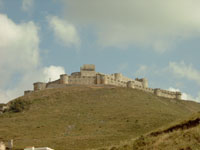 In the green North-West of Syria we visit the crusader castles Qalaat Marqab and Krak des Chevaliers. On our way to the latter we get lost on the little roads and end up in a completely Greek area. The people look Greek, the houses look Greek and instead of mosques there are Greek-Orthodox churches. In the gardens behind the houses people even have pigs. In Syria (and in Jordan and Lebanon too by the way) at least 10% of the population are Christian, here the Islam has no special position like in e.g. Iran.
In the green North-West of Syria we visit the crusader castles Qalaat Marqab and Krak des Chevaliers. On our way to the latter we get lost on the little roads and end up in a completely Greek area. The people look Greek, the houses look Greek and instead of mosques there are Greek-Orthodox churches. In the gardens behind the houses people even have pigs. In Syria (and in Jordan and Lebanon too by the way) at least 10% of the population are Christian, here the Islam has no special position like in e.g. Iran.
Krak des Chevaliers is an impressive crusader castle. It looks a bit like the Marienburg (Malbork) in Poland, which is no surprise since it has been built by the same firm (department Johanniter).
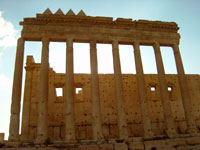 The road to Palmyra, the antique trading city about 200 km east of Damascus, runs straight through the desert. The green has fully disappeared in Palmyra; after kilometres of yellowish steppe only sand and stones remain in this part of the desert. During our drive to Palmyra we see many Bedouin families walking in the desert with their herds of sheep and goats or sitting in front of their dark brown tents. Sometimes you see an oasis of green palm trees in the middle of all the yellow and brown stone. Usually a herd of camels grazes near it. Every now and then a village of square or beehive formed mud huts in the same colour as the surrounding desert appears. Not much has changed here over the past 2000 years.
The road to Palmyra, the antique trading city about 200 km east of Damascus, runs straight through the desert. The green has fully disappeared in Palmyra; after kilometres of yellowish steppe only sand and stones remain in this part of the desert. During our drive to Palmyra we see many Bedouin families walking in the desert with their herds of sheep and goats or sitting in front of their dark brown tents. Sometimes you see an oasis of green palm trees in the middle of all the yellow and brown stone. Usually a herd of camels grazes near it. Every now and then a village of square or beehive formed mud huts in the same colour as the surrounding desert appears. Not much has changed here over the past 2000 years.
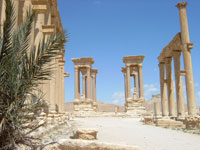
In Tadmur however, a lot has changed over the past 2000 years. Back then the little village was part of the important trading city Palmyra, one of the most splendid cities in that time. Now the village lives on tourism and from all sides people come running up to us and offer us donkey, camel or rickshaw rides, hotels and restaurants. And of course we have to buy their carpets and kilims. We refuse all offers and start our Palmyra tour. Palmyra is truly splendid: an enormous antique city, which well preserved temples, colonnaded streets, city gates and market squares lie exotically between the palm trees of the oasis. The museum in Tadmur was a bit of a disappointment, but the view from the Arabic fortress on the hill over the Roman city in the light of the setting sun is an absolute must! Also worth seeing is the necropolis with the splendidly ornamented grave towers and subterranean tombs from the high days of Palmyra.
Because of the heat, everyone is spending the evenings outside on the pavement, smoking water pipe (nargilé, or for the western tourists "hubbly bubbly"). Some of the men are lying on a mattress on the pavement, wearing a shirt as long as a dress (later Coen also bought one of these in Damascus).
The last stop before we cross the border to Jordan is Maloula, an Orthodox mountain village, which white and blue coated houses lie beautifully against the mountain wall. We visit the monasteries there and burn a candle for Coen's grandmother, who died a few days ago and will be buried tomorrow.
If you want, you can click here to read our travelogue of Jordan first, before continuing with the second part of Syria.
Part 2: Northbound (06.07.03 - 18.07.03)
Written by: Dorrit
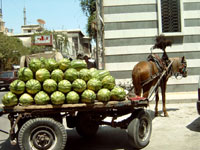 And again the border crossing is no fun outing and takes at least 2 hours, partly because we try to get around paying the EUR 100 diesel tax. After all, it is a ridiculous rule since you don't have to pay anything if you are driving a petrol car. We ask about driving to Lebanon, but there diesel cars are not allowed in at all. We will have to save Lebanon for some other time then.
And again the border crossing is no fun outing and takes at least 2 hours, partly because we try to get around paying the EUR 100 diesel tax. After all, it is a ridiculous rule since you don't have to pay anything if you are driving a petrol car. We ask about driving to Lebanon, but there diesel cars are not allowed in at all. We will have to save Lebanon for some other time then.
Our second trip through Syria we start by visiting Bosra - yet another Roman city - this time built in dark grey basalt and still inhabited. Here you can see families living in completely preserved Roman houses. They even behave like Romans: are lying on a sofa on their veranda's during the hot hours of the day or are carrying their shopping on their heads in the 2000 year old, cobblestone roads. At a little bakery the women buy whole stacks of flat breads and spread these out over the ruins and fallen columns to dry before they carry them home. As if you are walking in an open air museum.
In the evening we sit down on a little bench at the square and look at the film "life in Syria": a little scooter drives by, carrying 5 (!) men; a 30 year old bus, richly decorated in the same fashion as in Pakistan, comes round the corner, on its roof melons and stacks of hay; passing families are welcoming us to Syria. We hear music and singing and are getting curious. On a little square a wedding is going on: about 200 people (men, the women are standing in a corner and are only allowed to look on) are singing and dancing, waving enormous Arabic swords.
When we want to drive away from Bosra, we have our first flat tire of the journey. Good to have 2 spares, so that we can wait with repairing this tire until Turkey.
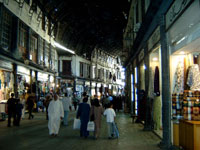 Next station is Damascus, where we have to fight our way through the horribly chaotic traffic. Imagine an enormous crowd of people that has to go through one tiny door and you have a good picture of Damascus' traffic situation. Everyone is honking loudly and incessantly, takes priority and races onto the road without even pretending to look in the mirror. 90% of the traffic are taxi's, which explains a lot.
Next station is Damascus, where we have to fight our way through the horribly chaotic traffic. Imagine an enormous crowd of people that has to go through one tiny door and you have a good picture of Damascus' traffic situation. Everyone is honking loudly and incessantly, takes priority and races onto the road without even pretending to look in the mirror. 90% of the traffic are taxi's, which explains a lot.
The whole medieval centre of Damascus, surrounded by a fairly well kept city wall, is declared Unesco world heritage. And for good reason: it is a fantastic area which brings the Middle Ages back to life. A labyrinth of narrow cobblestone streets with timbered houses, age-old monasteries, churches, Maria chapels, mosques, medresses (Koran schools) and khans (Ottoman trade centres around a courtyard) lies in a circle around the heart of the old centre: the suqs. The suqs are narrow, covered market alleys that are bulging with an enormous number of tiny shops and stalls, which in their turn bulge with an enormous number of goods on sale. All in all about 12 km "shopping mall". The eldest streets are over 2000 years old (and mentioned in the bible) and the facades of the shops are dating from the Roman times. Many shops have been renovated in the Ottoman time and have marvellous, 19th century interiors. Crowds of people swarm through the narrow alleys, many of them Iranian pilgrims in chador (a black dress that covers your whole body), because Damascus is - after Mecca, Medina and Jerusalem - the 4th holy place for the Islam. We hardly see other western tourists here.
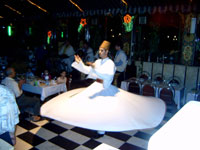
There is a suq for everything you can imagine: a herb suq (where it smells deliciously), a carpet and kilimsuq, a damask suq, a brocade suq, a water pipe suq etc. etc. We spend the next 4 days in the suqs and still have the feeling we have not even seen half of all there is. What a fantastic city.
In the evening we walk through the book suq to the highly recommended restaurant "Abu al Ezz". In this magnificent restaurant, decorated as a 19th century palace, we spend the whole night eating the most delicious Syrian dishes. In the meantime a live band is playing in the background and a Dervish dancer is performing his best dances. If you ever visit Damascus, make sure you go here to eat.
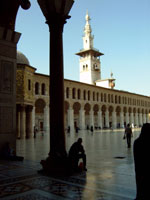
Another tip is the enormous Umayyad mosque in the middle of the suq area. North of the mosque itself is the courtyard, which walls are splendidly decorated with gold coloured mosaics and which floors are covered with marble stone mosaics. Inside people are sitting or lying on the most beautiful and expensive Turkish, Turkmen and Persian carpets that cover the whole prayer room. Centrepiece of the mosque is the tomb with the head of John the Baptist, who is also seen as a prophet by the Islamic religion. Thus fully covered Iranian women stand side by side with modern dressed Arabic Christians to see the tomb of "their" prophet.
The national museum is rather disappointing: although there are some nice parts (like a reconstructed Palmyran tomb, a clay tablet with the eldest alphabet of the world and a 19th century palace chamber in Damascene style), most of the pieces are displayed in a rather dull way and not always "subtitled".
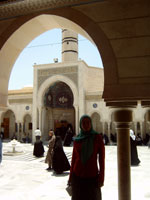
We also visit the Rukkaya mosque, a pilgrims place because a member of Mohammed's family is buried here. Inside it is very crowded, men are singing passionately and are hitting themselves on the breast like madmen. The women are lying against the wall of the tomb and are crying loudly or are sitting on the floor, hitting themselves on the breast and crying. This time it is our turn to look open mouthed at the people around us instead of the other way round. But only for a very short time, then we get the hell out of there.
One last visit to the suqs, where the water in the canals has turned red by the blood of a freshly slaughtered animal, where 10 year old boys are dragging enormous heaps or boxes through the streets (school? Yeah, they have heard somebody speak about it once, that's true...) and where men are sitting on the pavement in front of the city hall behind their typewriters, filling in forms or reading out texts for the analphabetic Bedouins.
Then we leave this marvellous city behind.
In the catholic monastery Deir Mar Musa, in the middle of the desert east of Nebek, we recover two days from Damascus. Among other things we attend a catholic mass in Arabic language, performed by the Italian father and German monk that lead the monastery. The service takes place in a Bedouin tent in front of the church, because the 1400 year old church is being restored.
During the evening meal that follows the service we talk with the German monk. He tells us that he was travelling the world just like us, but liked this monastery so much that he stayed there. He became catholic, followed the necessary education to become a monk and now plans to stay in the monastery for the rest of his life.
On the motorway to Hama we see the strangest things again, like a man walking along the side of the road from his car to the petrol station, carrying the petrol tank of his car (that he obviously screwed off) on his shoulder. Or trucks that drive on the wrong side of the road, straight towards the oncoming traffic. The motorbike driver in T-shirt without helmet, that races past with 120 km/h does not even impress us anymore.
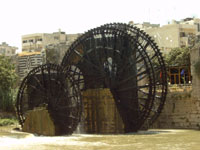 Hama is famous for its enormous, age-old water wheels, the so-called "norias". Everywhere along the riverside you see and hear the gigantic wooden wheels turning.
Hama is famous for its enormous, age-old water wheels, the so-called "norias". Everywhere along the riverside you see and hear the gigantic wooden wheels turning.
We continue to Apameia (Afamia), where a 2 km long colonnaded street and some ruins is all there is left of the once so thriving Roman trading city. The columns are beautifully situated in the midst of grass and wheat fields. The population of the little village near Afamia is staring intensely again and the children are running after us, shouting "hello" and asking to be photographed.
We exchange the ruins of Afamia for those of Serjila, a Byzantine town that was deserted in the 6th century. The outer walls of most buildings are still in good shape, only the roofs and the interiors are gone. It is a bit spooky (and hard to find: 35° 38' 481").
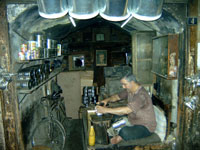 Aleppo, the second city of Syria and according to some at least as good as Damascus, is a little disappointing. Okay, the suqs are older than those of Damascus (Aleppo is one of the oldest cities in the world), but they are also a lot dirtier and the sales people are very annoying. The men stare and make remarks or funny sounds when they see me, although I am wearing long trousers and long sleeves in this heat. We later hear from a family from Bahrain (the girls like me without headscarf) that they were being harassed by the men here too. These men are of the opinion that an uncovered girl is a bad girl for which they don't have to show respect. I ignore them as much as possible, but when one of them feels the need to squeeze I have had enough and hit him on his head. I have my limits.
Aleppo, the second city of Syria and according to some at least as good as Damascus, is a little disappointing. Okay, the suqs are older than those of Damascus (Aleppo is one of the oldest cities in the world), but they are also a lot dirtier and the sales people are very annoying. The men stare and make remarks or funny sounds when they see me, although I am wearing long trousers and long sleeves in this heat. We later hear from a family from Bahrain (the girls like me without headscarf) that they were being harassed by the men here too. These men are of the opinion that an uncovered girl is a bad girl for which they don't have to show respect. I ignore them as much as possible, but when one of them feels the need to squeeze I have had enough and hit him on his head. I have my limits.
Outside the suqs the city looks a bit gray, restaurants are very hard to find and then usually very expensive and touristy. Which means we eat instant food in the camper.
The only thing that is really good about Aleppo is its citadel, lying on top of a high hill in the middle of the centre. Here, we spend a nice day roaming around the corridors, gates, halls, prison cellars and watchtowers. Very nice. We spend the hot hours of the day in a very cosy courtyard under a roof of wine leaves, smoking water pipe. The only nice terrace we managed to find in Aleppo - and we have searched a lot - and that directly next to where the camper is parked (ca. 200 metres east of the national museum, next to the mosque).
Our last day in Syria is spent picnicking at a nice place between Aleppo and the border, where pickup trucks with at least 20 field workers in the back drive past and an ice cream seller gives us half a litre of ice cream as a present. Then we leave "Arabistan" as the Turks call it and cross the border at Reyhanli. Here we actually manage - with a lot of bluff poker, pretending not to understand and more important: luck - not to pay any diesel tax for the second week we stayed in Syria. Good for us, saves us EUR 100!
Dorrit
|
 |
|
 |
 |
 |
 |
Our top 4: |
 |
 |
1. Damascus
2. Palmyra
3. Bosra
4. Krak des Chevaliers
|
 |
 |
 |
 |
 |
 |
 |
 |
Border costs: |
 |
 |
1. Diesel tax:
EUR 100 / week
2. Car insurance:
EUR 60 / month
3. Visa:
EUR 35 / person
4. Carnet processing:
EUR 2
|
 |
 |
 |
 |
 |
 |
 |
 |
Warning: |
 |
 |
Watch out for the infamous "speed breakers": they are only seldom indicated or marked and thus hardly visible. You can really ruin your car on them!
|
 |
 |
 |
 |
 |
 |
 |
 |
Warning (2): |
 |
 |
Despite the EUR 100 diesel tax per week, the quality of the diesel in Syria is very poor.
|
 |
 |
 |
 |
 |
 |
 |
 |
TIP: |
 |
 |
We managed to get our Syrian visa at the Jordan border without any problem.
|
 |
 |
 |
 |
 |
 |
 |
 |
TIP: |
 |
 |
In Damascus, opposite of the Cham Palace Hotel, a cash machine has been installed that also accepts foreign bank cards. However, on Friday it is switched off.
|
 |
 |
 |
 |
 |
 |
 |
 |
Restaurant tip: |
 |
 |
Damascus: Abu 'l Ezz in the book-suq, from the Omaijad mosque's western gate westwards, turn right as soon as you are in the covered area.
|
 |
 |
 |
 |
 |
 |
 |
 |
Eat tip: |
 |
 |
Aleppo: In Baron street, just south of the sleazy Ugarit cinema you will find a good hamburger and fruitjuice cafe.
|
 |
 |
 |
 |
 |
 |
|


